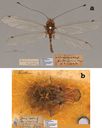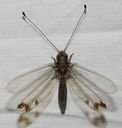Owlflies
Ascalaphinae
Classification
- Phylum: Arthropoda
- Subphylum: Hexapoda
- Class: Insecta
- Order: Neuroptera
- Suborder: Myrmeleontiformia
- Family: Myrmeleontidae
- Subfamily: Ascalaphinae
Pronunciation
How to pronounce Ascalaphinae: //ˌæ.skəˈlæ.fɪ.niː//
These audio files are automatically generated. While they are not always 100% accurate, they are a good starting point.
Images






Summary
Ascalaphinae, also known as owlfies, is the type subfamily of the Ascalaphidae family, characterized by their split eyes and predatory larvae, predominantly found in tropical regions.
Physical Characteristics
Bizarre creatures resembling a cross between a dragonfly and a butterfly; they have prominent clubbed antennae.
Identification Tips
Key characters include wing venation and eye structure; species in Ululodes have divided eyes, while Ascaloptynx have undivided eyes.
Habitat
Worldwide, mostly tropical; in the US, mostly southern regions with known local faunas in North Carolina, Florida, and Kansas.
Distribution
Approximately 430 spp. in almost 100 genera globally; in North America with at least 8 species in 3 genera.
Diet
Larvae are voracious ambush predators, while adults are insectivores restricted to small prey.
Life Cycle
Eggs are laid on twigs; larvae lie on ground covered with debris waiting for prey; pupate in a silk cocoon in leaf litter.
Reproduction
Females lay eggs on twigs; reproduction details specific to each species may vary.
Ecosystem Role
Larvae act as ambush predators in their habitats, controlling populations of small insects.
Collecting Methods
- Netting adult owlfies during flight
- Searching under debris for larvae
Preservation Methods
- Pinning adults
- Preserving larvae in ethanol
Evolution
The first fossil record of the Ascalaphinae dates to the Miocene, indicating evolution occurred in the latter half or towards the end of the Paleogene.
Similar Taxa
- Myrmeleontidae (antlions)
- Haplogleniinae (unsplit-eyed owlflies)
Misconceptions
Often mistaken for dragonflies due to similar appearance; despite this, they are not closely related.
Tags
- Ascalaphinae
- Owlflies
- Neuroptera
- Insecta